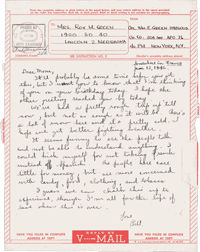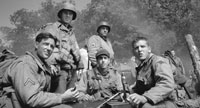V-Mail

V-Mail (Victory Mail) was a system designed to allow civilians and members of the American military to write to their friends and family overseas without creating large amounts of bulky mail. Space aboard planes and transport ships was at a premium, and shipments of personal mail could take up valuable space needed for weapons and supplies.
Speed was also of concern, as sacks of regular mail could take weeks to cross an ocean via regular shipping routes. Because of its reduced size, V-Mail correspondence could be placed aboard planes and delivered in significantly less time.
The V-Mail system (first developed by the British) used standard, pre-printed forms on which messages were written and addressed. These forms would then be folded and sealed to form an envelope that could be mailed.
Before making its way overseas, the contents of the envelope would be photographed and saved in 16mm microfilm format. Rolls of V-Mail microfilm took up considerably less space than regular letters. The microfilm was routed to a station near the recipient where it was reproduced at a reduced size and mailed to its final destination.
V-Mail was approved on June 15, 1942 and was in use until April 1, 1945. Although reasonably popular as a means of corresponding with their loved ones, most people continued to rely on standard mail.
Notes
Caparzo's bloodied V-Mail letter reveals that his parents lived on West 112th Street in New York and that he had written the letter on June 9th. Knowing that his letter would be read and possibly censored, Caparzo puts down his location as "Somewhere in France." After Caparzo's death the letter is taken by Medic Wade, who recopies the letter to a fresh V-Mail form. The letter then passes to Captain Miller following Wade's death, and ultimately to Private Reiben following Miller's death.

